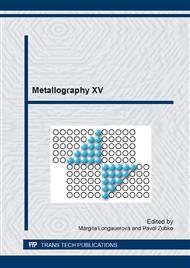p.607
p.611
p.615
p.619
p.623
p.629
p.635
p.641
p.645
Determination of Causes of Corrosion Damage of a Roman Vessel from an Early Tiberian Period
Abstract:
The study deals with a material survey and determination of the corrosion character of a Roman bronze vessel from an early Tiberian period. The ancient technology of the bronze vessel production was determined based on the evaluation of structural properties of the material using the prepared metallographic sections. The vessel was produced by combining the technologies of beating and metal embossing in a pre-cast bronze piece, side ornaments were cast from bronze. Chloride anions were identified along the material grains. It was identified that the mixture of corrosion products covering the surface of the vessel contained, in addition to other elements, basic copper chloride. The presence of chloride anions, atmospheric humidity and mechanical stress lead to corrosion of the bronze vessel called the bronze disease. The material in the upper part of the vessels lost cohesion completely and the neck of the vessel broke as a result of the corrosion process. The vessel was desalinated and reconstructed in a relatively unique way. At present, the vessel is a property of the National Museum in Prague.
Info:
Periodical:
Pages:
645-648
Citation:
Online since:
April 2014
Authors:
Keywords:
Price:
Сopyright:
© 2014 Trans Tech Publications Ltd. All Rights Reserved
Share:
Citation:


